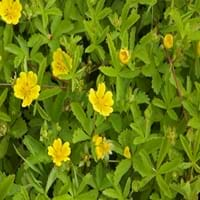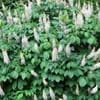Life Span
Perennial
Perennial
Origin
Southeastern United States
Hybrid origin
Types
Not available
Potentilla bifurca, Potentilla biennis
Number of Varieties
Not Available
Habitat
Bluffs, Coastal Regions, Stream side, Woods
Fields, Open Forest, Upland
USDA Hardiness Zone
5-9
5-8
Sunset Zone
Not Available
2b, 3a, 3b, 4, 5, 6, 7, 8, 9, 10, 11, 12, 13, 14, 15, 16, 17, 18, 19, 20, 21, 22, 23, 24
Habit
Spreading
Cushion/Mound-forming
Flower Color
White, Pink
Not Available
Flower Color Modifier
Bicolor
Not Available
Leaf Color in Spring
Green
Not Available
Leaf Color in Summer
Dark Green
Not Available
Leaf Color in Fall
Lemon yellow, Yellow green
Not Available
Leaf Color in Winter
Not Available
Light Green
Leaf Shape
Palmate
Palmate
Plant Season
Spring, Summer, Fall
Summer, Fall
Sunlight
Full Sun, Partial Sun, Partial shade
Full Sun, Partial Sun
Type of Soil
Clay, Loam, Sand
Loam, Sand
The pH of Soil
Acidic, Neutral, Alkaline
Neutral, Alkaline
Soil Drainage
Average
Well drained
Bloom Time
Summer, Late Summer
Early Summer, Summer, Late Summer
Tolerances
Salt, Wind
Drought
Where to Plant?
Ground, Pot
Container, Ground, Pot
How to Plant?
Cuttings, Seedlings
Seedlings, Stem Planting
Plant Maintenance
Low
Medium
Watering Requirements
Keep the Soil well drained, Requires regular watering
Keep ground moist, Never Over-water, Requires regular watering
In Summer
Lots of watering
Lots of watering
In Spring
Moderate
Moderate
In Winter
Average Water
Average Water
Soil pH
Acidic, Neutral, Alkaline
Neutral, Alkaline
Soil Type
Clay, Loam, Sand
Loam, Sand
Soil Drainage Capacity
Average
Well drained
Sun Exposure
Full Sun, Partial Sun, Partial shade
Full Sun, Partial Sun
Pruning
Remove damaged leaves, Remove dead branches, Remove dead flowers, Remove dead leaves
Remove damaged leaves, Remove dead leaves, Remove deadheads
Fertilizers
14-14-14 Fertilizer, Apply N-P-K, slow-release fertilizers
as it is a flowering plant, use high phosphorous content fertilizer, Compost, fertilize in growing season, Nitrogen, organic fertlizers, Potassium
Pests and Diseases
Edema, Powdery mildew, Verticillium Wilt
Leaf spot
Plant Tolerance
Salt, Wind
Drought
Flower Petal Number
Single
Single
Foliage Texture
Coarse
Not Available
Foliage Sheen
Matte
Not Available
Attracts
Butterflies, Hummingbirds
Not Available
Allergy
Pollen
Avoid during Pregnancy
Aesthetic Uses
Cottage Garden, Showy Purposes
Beautification, Landscape Designing, Showy Purposes
Beauty Benefits
Not Available
Not Available
Environmental Uses
Air purification, Wildlife
Air purification, Food for insects
Medicinal Uses
Antirheumatic, Colic, constipation, Piles
Diarrhea, Inflammation, Menstrual Disorders, Sore throat
Part of Plant Used
Seeds
Leaves
Other Uses
Used for making soaps
Decoration Purposes, Showy Purposes, Used as Ornamental plant, Used for its medicinal properties
Used As Indoor Plant
No
Yes
Used As Outdoor Plant
Yes
Yes
Garden Design
Feature Plant, Foundation, Screening, Wind Break
Container, Foundation, Groundcover, Mixed Border, Rock Garden / Wall
Botanical Name
AESCULUS parviflora
POTENTILLA 'Emilie'
Common Name
bottlebrush buckeye, dwarf horse chestnut
Cinquefoil
In Hindi
Bottlebrush Buckeye
पंचकोण
In German
Buckeye Putzer
Fingerkraut
In French
Bottlebrush Buckeye
potentille
In Spanish
bottlebrush Buckeye
cinquefoil
In Greek
bottlebrush Buckeye
Πεντάφυλλο
In Portuguese
Bottlebrush Buckeye
cinquefoil
In Polish
Bottlebrush Buckeye
pięciornik
In Latin
bottlebrush Buckeye
cinquefoil
Phylum
Magnoliophyta
Magnoliophyta
Class
Magnoliopsida
Magnoliopsida
Family
Hippocastanaceae
Rosaceae
Genus
Aesculus
Potentilla
Clade
Angiosperms, Eudicots, Rosids
Angiosperms, Eudicots, Rosids
Tribe
Not Available
Not Available
Subfamily
Hippocastanoideae
Rosoideae
Number of Species
Not Available
Season and Care of Bottlebrush Buckeye and Cinquefoil
Season and care of Bottlebrush Buckeye and Cinquefoil is important to know. While considering everything about Bottlebrush Buckeye and Cinquefoil Care, growing season is an essential factor. Bottlebrush Buckeye season is Spring, Summer and Fall and Cinquefoil season is Spring, Summer and Fall. The type of soil for Bottlebrush Buckeye is Clay, Loam, Sand and for Cinquefoil is Loam, Sand while the PH of soil for Bottlebrush Buckeye is Acidic, Neutral, Alkaline and for Cinquefoil is Neutral, Alkaline.
Bottlebrush Buckeye and Cinquefoil Physical Information
Bottlebrush Buckeye and Cinquefoil physical information is very important for comparison. Bottlebrush Buckeye height is 180.00 cm and width 180.00 cm whereas Cinquefoil height is 30.50 cm and width 38.10 cm. The color specification of Bottlebrush Buckeye and Cinquefoil are as follows:
Bottlebrush Buckeye flower color: White and Pink
Bottlebrush Buckeye leaf color: Green
Cinquefoil flower color: Not Available
- Cinquefoil leaf color: Not Available
Care of Bottlebrush Buckeye and Cinquefoil
Care of Bottlebrush Buckeye and Cinquefoil include pruning, fertilizers, watering etc. Bottlebrush Buckeye pruning is done Remove damaged leaves, Remove dead branches, Remove dead flowers and Remove dead leaves and Cinquefoil pruning is done Remove damaged leaves, Remove dead leaves and Remove deadheads. In summer Bottlebrush Buckeye needs Lots of watering and in winter, it needs Average Water. Whereas, in summer Cinquefoil needs Lots of watering and in winter, it needs Average Water.





